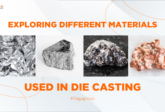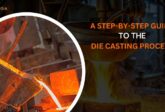Common Die Casting Defects and How to Prevent Them

Die casting is an essential manufacturing process in various industries, known for its ability to produce complex, high-quality parts quickly and efficiently. However, like any manufacturing technique, it’s not without its challenges. Understanding and preventing die casting defects is crucial to producing flawless, high-performance parts, minimizing waste, and reducing costs. In this article, we’ll discuss common die casting defects, their causes, and effective preventive strategies.
Understanding Die Casting Defects
What are Die Casting Defects?
Die casting defects are imperfections that occur during the casting process. These flaws may appear on the surface, within the structure, or in the form of dimensional inaccuracies. Such defects can weaken the structural integrity of the part, reduce its aesthetic appeal, and make it unsuitable for its intended application.
Common Types of Die Casting Defects
Here are some of the most common types of defects seen in die casting:
- Porosity: Small holes or voids in the material, often caused by trapped gases.
- Cold Shuts: Areas where molten metal doesn’t fuse properly, creating a visible line.
- Flash: Excess material around the edges of the casting, resulting from leaking at the mold joint.
- Misruns: Incomplete filling of the die cavity, leading to missing or incomplete sections.
- Soldering: Parts of the casting that stick to the die due to high temperatures or poor release agent application.
Causes of Die Casting Defects
Understanding the root causes of each defect is essential for developing strategies to prevent them.
- Porosity
- Causes: Gas entrapment during casting and poor venting design can trap gases, leading to internal or surface porosity.
- Impact: Porosity can weaken the part structurally and affect its appearance.
- Cold Shuts
- Causes: Cold shuts occur when two streams of molten metal do not fuse, often due to low melt temperature, improper filling, or low injection speed.
- Impact: Cold shuts weaken the material and create visible lines on the part.
- Flash
- Causes: Excess material or improper gating can cause leaks around the mold parting line, creating thin layers of extra material known as flash.
- Impact: Flash affects the part’s appearance, requires extra finishing work, and can impact dimensional accuracy.
- Misruns
- Causes: Inadequate metal flow, incorrect temperature, or low injection speed can lead to incomplete filling, resulting in misruns.
- Impact: Misruns compromise the functionality of the part and result in waste.
- Soldering
- Causes: Excessive heat, improper lubrication, or low iron content in the alloy can cause soldering, where molten metal adheres to the die.
- Impact: Soldering results in material buildup on the part, requiring rework or potentially scrapping the part.
How to Prevent Die Casting Defects
Effective prevention strategies target both design and process adjustments to minimize defects.
- Optimizing Gate and Venting Design
- Proper placement of gates and vents helps gases escape from the mold, reducing the risk of porosity and improving the overall quality of the part.
- Solution: Ensure that the gate and venting design allows for smooth metal flow and efficient gas escape.
- Controlling Metal Flow
- Minimizing turbulence during injection can reduce gas entrapment and create a smoother casting.
- Solution: Adjust injection speed and pressure to achieve a steady, controlled metal flow.
- Using Vacuum-Assisted Casting
- Vacuum systems remove trapped air and gases from the die, significantly reducing porosity in the final part.
- Solution: Use vacuum-assisted casting techniques when manufacturing high-integrity, precision parts to eliminate internal voids.
- Proper Lubricant Application
- Applying the right amount of high-quality mold-release agents prevents soldering without causing porosity.
- Solution: Use the correct type and amount of lubricant, and ensure that it’s evenly applied to the die cavity.
- Ensuring Uniform Cooling
- Consistent cooling reduces shrinkage porosity and helps parts solidify evenly, preventing warping and deformation.
- Solution: Use a well-regulated cooling system and ensure uniform cooling across all sections of the die.
Conclusion
Preventing die casting defects is essential for producing high-quality parts that are both functional and visually appealing. By understanding the types and causes of common defects and applying preventive measures, manufacturers can reduce waste, lower costs, and improve overall product reliability. With careful attention to design, materials, and machine parameters, you can minimize casting defects and ensure that your products meet industry standards.
FAQs
Q: What is the most common die casting defect?
A: Porosity is one of the most frequent issues due to gas entrapment and poor venting.
Q: How can I prevent cold shuts?
A: Ensure proper temperature control and filling techniques to avoid unjoined molten streams.
Q: What causes flash in die casting?
A: Flash occurs due to excess material and improper gating in the casting mold.
Q: How can I reduce misruns?
A: Optimize metal flow, control injection speed, and maintain proper machine parameters.
Q: What is soldering in die casting?
A: Soldering happens when parts stick to the die surface due to high temperatures and insufficient lubrication.




